26 August 2016
At the risk of sounding like a chocolate snob, I must insist that chocolate is NOT just chocolate. It’s like saying to a fashionista that clothes are just clothes, or to a wine connoisseur that wine is just wine…..
To elaborate, let me take you back in time – to the start of my Belgian chocolates tour. We are standing around the tantalising display of chocolates at Leonidas, in the Galeries Royales St Hubert. Our guide, Wanda, holds out a tray of bite-sized white chocolates. We take a piece each and sink our teeth into it, after which Wanda asks “Do you know what this is called?” Some stay silent, looking puzzled. “White chocolate”, I respond. “Yes, it’s covered in white chocolate, but what’s inside?” she replies. “This is called butter cream”, she eventually answers her own question.
Butter Cream
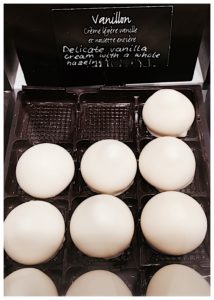 What is butter cream? As the name suggests, it’s chocolate containing a filling of butter and fresh cream, as well as milk and sugar. The ingredients are heated and mixed, then cooled and piped into moulded chocolate. Alternatively, the mixture is hardened through refrigeration, cut into shapes or shaped into balls, then enrobed in chocolate.
What is butter cream? As the name suggests, it’s chocolate containing a filling of butter and fresh cream, as well as milk and sugar. The ingredients are heated and mixed, then cooled and piped into moulded chocolate. Alternatively, the mixture is hardened through refrigeration, cut into shapes or shaped into balls, then enrobed in chocolate.
Truffle
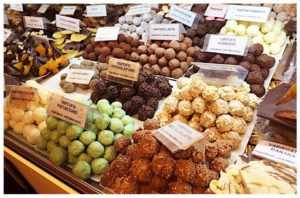
Next, she points to the round balls of chocolate, dusted in powder. “Truffles”, answers one of the chocolate enthusiasts in the group. Wanda nods her head. This type of chocolate derives its name from the expensive, rare and highly sought after fungal delicacy.
The truffle is typically circular or spherical, and comprised of a chocolate ganache that is coated in cocoa powder, nuts or a combination of the two. The truffle may also be a ganache filled into a round chocolate shell, which is then dusted in cocoa powder, nuts or a combination of both. Sometimes, the truffle may be liquid-filled, for example the champagne and liquor truffle.
Ganache
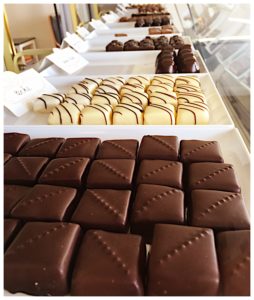
The ganache has French origins. “The difference between the ganache and the butter cream is the addition of chocolate to the filling”, according to Wanda.
To make a ganache, heated cream is added to chocolate and stirred, after which butter, sugar and other ingredients are mixed in to create the final flavoured ganache. The ganache may be piped into moulded chocolate or hardened and cut into shapes, then enrobed in chocolate.
Praline
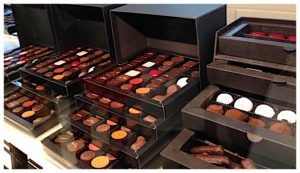 “Crunchy pralines are my favourite”, I tell Wanda. She explains that the traditional praline comprises almonds, usually crushed, coated with caramelised sugar and enrobed in chocolate. Crushed hazelnuts may sometimes be added.
“Crunchy pralines are my favourite”, I tell Wanda. She explains that the traditional praline comprises almonds, usually crushed, coated with caramelised sugar and enrobed in chocolate. Crushed hazelnuts may sometimes be added.
However, and confusingly, a praline can also be used as the generic term for any bite-sized filled chocolate. I prefer to stick to its traditional meaning.
Gianduja or Gianduia
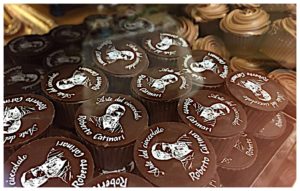 This chocolate originates from the Piedmont region of Italy, the home of Italian hazelnuts. As you’ve probably guessed, the gianduja is hazelnut-containing chocolate.
This chocolate originates from the Piedmont region of Italy, the home of Italian hazelnuts. As you’ve probably guessed, the gianduja is hazelnut-containing chocolate.
Hazelnuts are ground to a paste and piped into moulded chocolate. Alternatively, the hazelnut paste may be mixed into chocolate which is then set in moulds, or piped into swirls and set.
Rocher
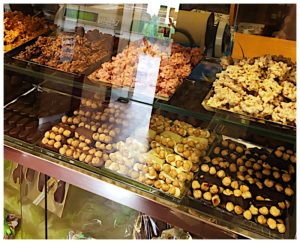 Rocher means rock, in French. In chocolate terms, it refers to slivers or whole pieces of nuts, usually almonds, coated in caramelised sugar, then dipped in chocolate and shaped into small rocks.
Rocher means rock, in French. In chocolate terms, it refers to slivers or whole pieces of nuts, usually almonds, coated in caramelised sugar, then dipped in chocolate and shaped into small rocks.
Mendiant
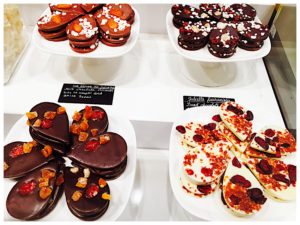 The mendiant has its historical origins in France. It’s the word for “beggar” in French and was originally created to represent the mendicant or religious figures who rely solely on the charity of others to survive.
The mendiant has its historical origins in France. It’s the word for “beggar” in French and was originally created to represent the mendicant or religious figures who rely solely on the charity of others to survive.
As a chocolate, the mendiant is a thin disc, studded with nuts and dried fruit. While available throughout the year, it’s typically enjoyed during the festive Christmas period.
Marzipan
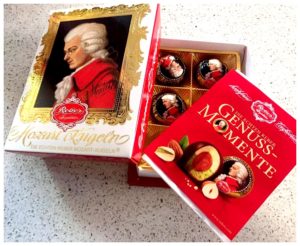
The traditional marzipan is a paste made of sugar, almond meal, and occasionally honey and almond extract. The paste is cut or shaped into bite-sized pieces and enrobed in chocolate.
The mozartkugel, of Austrian (and contentious German) origin, is a variant of this. Named after the famous musician, Wolfgang Amadeus Mozart, it’s pistachio marzipan with nougat, covered in dark chocolate.
Bar or Tablet
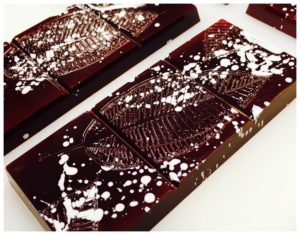 Perhaps the most ubiquitous and widely known of all chocolates, the bar or tablet is simply chocolate, set in a rectangular or square mould. The chocolate may be flavoured, ingredients like dried fruit and nuts may be added or it may be filled.
Perhaps the most ubiquitous and widely known of all chocolates, the bar or tablet is simply chocolate, set in a rectangular or square mould. The chocolate may be flavoured, ingredients like dried fruit and nuts may be added or it may be filled.
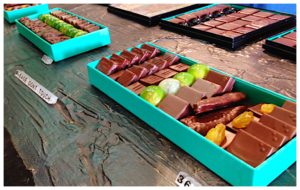 At the conclusion of the tour, we are grouped around the display of Patrick Roger’s masterful creations. Wanda points to different varieties of chocolates and asks us to name them, as a test of our knowledge. Suffice to say, we all pass with flying colours.
At the conclusion of the tour, we are grouped around the display of Patrick Roger’s masterful creations. Wanda points to different varieties of chocolates and asks us to name them, as a test of our knowledge. Suffice to say, we all pass with flying colours.
There’s a lot to be learnt and appreciated about chocolates. Whilst I don’t expect us all to be experts or enthusiasts, I do ask you to spare a thought for the history, skills, artistry and creativity that have gone into the creation of each chocolate variant.
Therefore, when you take your next bite of chocolate, please give it the recognition that it deserves and call it by its name!
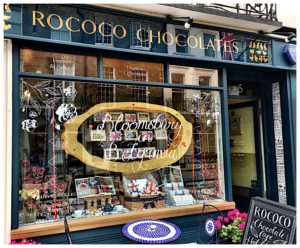 Our first stop takes us to the very well heeled district of Belgravia. The “older of the new”, established in the early 80s, Rococo is regarded as a pioneer of fine English chocolates. The shop exudes country charm. There’s a retail section out front, of shelves and a large glass counter brimming with chocolates, and a cozy cafe to the back, serving teas, hot chocolate and cakes. I’m immediately drawn to the hand-made beauties, in particular the painted sardines. Almost too beautiful to consume.
Our first stop takes us to the very well heeled district of Belgravia. The “older of the new”, established in the early 80s, Rococo is regarded as a pioneer of fine English chocolates. The shop exudes country charm. There’s a retail section out front, of shelves and a large glass counter brimming with chocolates, and a cozy cafe to the back, serving teas, hot chocolate and cakes. I’m immediately drawn to the hand-made beauties, in particular the painted sardines. Almost too beautiful to consume.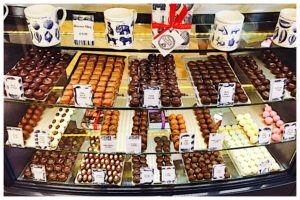 The kalamansi lime caramel grabs my interest and I give it a go. On the outside, it’s dark chocolate decorated with splashes of green cocoa butter. I take my first bite and my tastebuds are immediately shipped away to a tropical paradise. The shell, thin and well tempered, releases bursts of sweet and tangy kalamansi-infused caramel to create a refreshing taste sensation on the palate.
The kalamansi lime caramel grabs my interest and I give it a go. On the outside, it’s dark chocolate decorated with splashes of green cocoa butter. I take my first bite and my tastebuds are immediately shipped away to a tropical paradise. The shell, thin and well tempered, releases bursts of sweet and tangy kalamansi-infused caramel to create a refreshing taste sensation on the palate.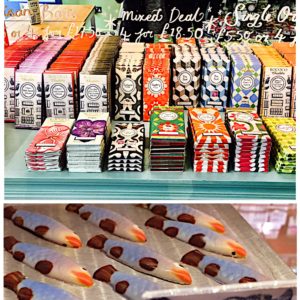
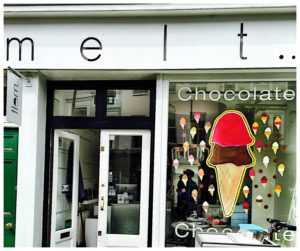 Next, we make our way to cosmopolitan and trendy Notting Hill, passing many a kebab shops and middle eastern eateries along the way, until we arrive at Melt. By London standards, Melt, can be considered a newcomer to the chocolate scene. The deco reflects this, with a contemporary and bright interior that oozes style and openness. From the entrance, I can see right through to the kitchen at the back, where their chocolates are meticulously hand-crafted. On this day, they are making caramel, which hubby and I have the pleasure of sampling. You can’t walk past the “Wall of Chocolate”, without pausing to examine it. It’s actually a plain shelf, but decorated with eye-catching, vibrant coloured chocolate bars of multiple varieties.
Next, we make our way to cosmopolitan and trendy Notting Hill, passing many a kebab shops and middle eastern eateries along the way, until we arrive at Melt. By London standards, Melt, can be considered a newcomer to the chocolate scene. The deco reflects this, with a contemporary and bright interior that oozes style and openness. From the entrance, I can see right through to the kitchen at the back, where their chocolates are meticulously hand-crafted. On this day, they are making caramel, which hubby and I have the pleasure of sampling. You can’t walk past the “Wall of Chocolate”, without pausing to examine it. It’s actually a plain shelf, but decorated with eye-catching, vibrant coloured chocolate bars of multiple varieties.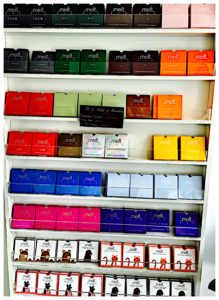 Hubby and I both hone in on the “Smoke” 64% dark chocolate bar. We ask to sample it and the lady serving us obliges. It has a toasty, earthy nose. As it melts on my tongue, the texture is smooth and velvety. I taste a hint of initial caramel, which gives way to more earthy flavours. Then, the ever so mild bitterness of charcoal, which lingers on the palate after all the chocolate has melted away. We read from the packaging that the bar is made from Criollo cocoa beans, grown in the volcanic islands of Sao Tome.
Hubby and I both hone in on the “Smoke” 64% dark chocolate bar. We ask to sample it and the lady serving us obliges. It has a toasty, earthy nose. As it melts on my tongue, the texture is smooth and velvety. I taste a hint of initial caramel, which gives way to more earthy flavours. Then, the ever so mild bitterness of charcoal, which lingers on the palate after all the chocolate has melted away. We read from the packaging that the bar is made from Criollo cocoa beans, grown in the volcanic islands of Sao Tome.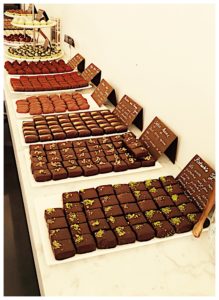 We follow through with the “Wild” 68% dark chocolate bar, named after the wild Bolivian criollo cocoa beans that have gone into its production. The nose is rather interesting – I smell bursts of chestnuts, interspersed with hints of mushroom. The texture on my tongue is even smoother than the “Smoke” bar. The taste brings back fond memories of Amedei. It starts with sweetened lemons, is quickly replaced by aniseed and finishes off with a lingering flavour that I can only describe as being that of mild flavoured mushrooms. The larger than bite size pralines and ganaches are also delectable. I recommend the textural pleasure of the salted praline cup and the fresh flavours of the passion and mango (gel) square.
We follow through with the “Wild” 68% dark chocolate bar, named after the wild Bolivian criollo cocoa beans that have gone into its production. The nose is rather interesting – I smell bursts of chestnuts, interspersed with hints of mushroom. The texture on my tongue is even smoother than the “Smoke” bar. The taste brings back fond memories of Amedei. It starts with sweetened lemons, is quickly replaced by aniseed and finishes off with a lingering flavour that I can only describe as being that of mild flavoured mushrooms. The larger than bite size pralines and ganaches are also delectable. I recommend the textural pleasure of the salted praline cup and the fresh flavours of the passion and mango (gel) square.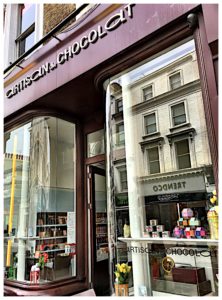 Still within Notting Hill is yet another renowned chocolate shop, famous for its No. 1 liquid sea salt caramels which were created for celebrity chef Gordon Ramsay. This is THE chocolate to try at Artisan du Chocolat. The gentleman serving us kindly offers us a sample, and we oblige. The taste is amazing – oozy, smooth caramel, sweet and lightly salted, enveloped in a rich, crisp dark chocolate shell and dusted with cocoa powder. Despite the French name, Irish born owner and chocolate maker Gerard Coleman actually honed his chocolate skills in London, after a training stint at Pierre Marcolini in Belgium.
Still within Notting Hill is yet another renowned chocolate shop, famous for its No. 1 liquid sea salt caramels which were created for celebrity chef Gordon Ramsay. This is THE chocolate to try at Artisan du Chocolat. The gentleman serving us kindly offers us a sample, and we oblige. The taste is amazing – oozy, smooth caramel, sweet and lightly salted, enveloped in a rich, crisp dark chocolate shell and dusted with cocoa powder. Despite the French name, Irish born owner and chocolate maker Gerard Coleman actually honed his chocolate skills in London, after a training stint at Pierre Marcolini in Belgium.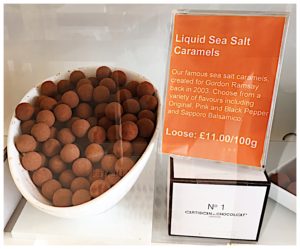 Apart from the sea salt caramels, there’s also a wide variety of indulgences to suit all tastes, from truffles, seasonal pralines and ganaches, through to specialty chocolates for those with specific dietary requirements. We are told that the chocolates are made from bean to bar, rather than using coverture.
Apart from the sea salt caramels, there’s also a wide variety of indulgences to suit all tastes, from truffles, seasonal pralines and ganaches, through to specialty chocolates for those with specific dietary requirements. We are told that the chocolates are made from bean to bar, rather than using coverture.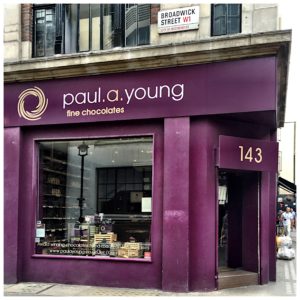 The last stop on this adventure is a visit to, in my opinion, perhaps the most bold and inventive of the lot. We head to the gentrified district of Soho, in search of multi award winning chocolatier, Paul A Young. You can’t miss the shop. It’s painted bright purple; perhaps the first glimpse into Paul’s personality? A large, round wooden table sits in the middle of the shop, and, on the day that we are there, the chocolates are presented on radially arranged trays.
The last stop on this adventure is a visit to, in my opinion, perhaps the most bold and inventive of the lot. We head to the gentrified district of Soho, in search of multi award winning chocolatier, Paul A Young. You can’t miss the shop. It’s painted bright purple; perhaps the first glimpse into Paul’s personality? A large, round wooden table sits in the middle of the shop, and, on the day that we are there, the chocolates are presented on radially arranged trays.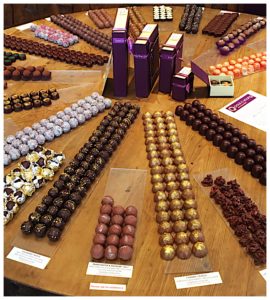 ancy a salted caramel or banoffee pie? Maybe a kalamansi truffle? Or peanut butter and raspberry jelly for those who enjoy the combination in a sandwich? There’s no end to the creativity and flavour combinations born from Paul’s imagination. I find the flavour combinations to be exciting and atypical, yet complimentary. Every selection is aesthetically pleasing; a true work of art. The sweetness levels, however, could be toned down a little.
ancy a salted caramel or banoffee pie? Maybe a kalamansi truffle? Or peanut butter and raspberry jelly for those who enjoy the combination in a sandwich? There’s no end to the creativity and flavour combinations born from Paul’s imagination. I find the flavour combinations to be exciting and atypical, yet complimentary. Every selection is aesthetically pleasing; a true work of art. The sweetness levels, however, could be toned down a little.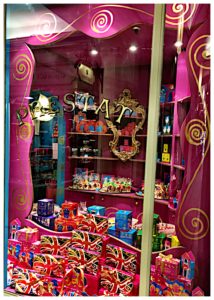 Our first stop looks like something out of Willy Wonka’s Chocolate Factory. In fact, I hear that it is THE inspiration for Roald Dahl’s Charlie and the Chocolate Factory. With its vibrant coloured displays and floor to ceiling selections in multi-shaped boxes, Prestat is a sure hit with kids and the young at heart. Like the character Augustus Gloop, I too am overwhelmed by the temptation to over-indulge in this magical chocolate shop.
Our first stop looks like something out of Willy Wonka’s Chocolate Factory. In fact, I hear that it is THE inspiration for Roald Dahl’s Charlie and the Chocolate Factory. With its vibrant coloured displays and floor to ceiling selections in multi-shaped boxes, Prestat is a sure hit with kids and the young at heart. Like the character Augustus Gloop, I too am overwhelmed by the temptation to over-indulge in this magical chocolate shop.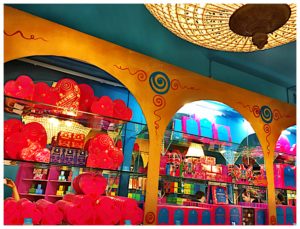 There are truffles and pralines abound in the glass display counter, and chocolate bars of various sizes and flavours sitting atop it. Help is at hand as the gentleman behind the counter steers me to the yuzu sake and red velvet truffles, apparently the latest crowd pleasers.
There are truffles and pralines abound in the glass display counter, and chocolate bars of various sizes and flavours sitting atop it. Help is at hand as the gentleman behind the counter steers me to the yuzu sake and red velvet truffles, apparently the latest crowd pleasers.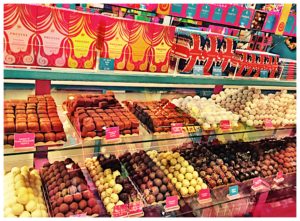 The yuzu sake truffle is refreshing. The tartness of the white chocolate yuzu ganache does wonders to complement the sweetness of the dark chocolate shell that envelops it. I am reminded of lemon sherbets, minus the fizzle. The sake is so subtle that it’s hardly discernible. As far as first impressions go, the red velvet truffle is attractive. It’s an inside out version of the traditional namesake. Dark pink, rounded beauties dusted with raspberry powder on the outside, icing on the inside and a milk chocolate shell in the middle. Top marks for creativity. As for the taste, I find it to be a tad too sweet for my liking. The tartness of the raspberry powder works to some extent to counter this, but the milk chocolate and icing combination tips the sugar scales in a truffle. Maybe dark chocolate could have worked better?
The yuzu sake truffle is refreshing. The tartness of the white chocolate yuzu ganache does wonders to complement the sweetness of the dark chocolate shell that envelops it. I am reminded of lemon sherbets, minus the fizzle. The sake is so subtle that it’s hardly discernible. As far as first impressions go, the red velvet truffle is attractive. It’s an inside out version of the traditional namesake. Dark pink, rounded beauties dusted with raspberry powder on the outside, icing on the inside and a milk chocolate shell in the middle. Top marks for creativity. As for the taste, I find it to be a tad too sweet for my liking. The tartness of the raspberry powder works to some extent to counter this, but the milk chocolate and icing combination tips the sugar scales in a truffle. Maybe dark chocolate could have worked better?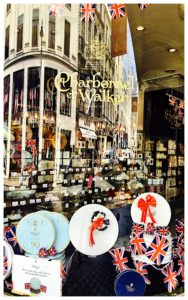
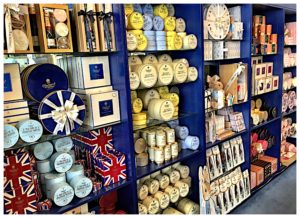 Drawing similarities with The Queen, Charbonnel et Walker is an English institution in itself, established back in 1875. Initially formed as a partnership between Mrs Walker and Madame Charbonnel, from an esteemed chocolate house in Paris, the chocolate shop has stood the test of time and maintains its Parisian chic to this day. Plus the chocolates are still meticulously handmade to traditional, age old recipes.
Drawing similarities with The Queen, Charbonnel et Walker is an English institution in itself, established back in 1875. Initially formed as a partnership between Mrs Walker and Madame Charbonnel, from an esteemed chocolate house in Paris, the chocolate shop has stood the test of time and maintains its Parisian chic to this day. Plus the chocolates are still meticulously handmade to traditional, age old recipes.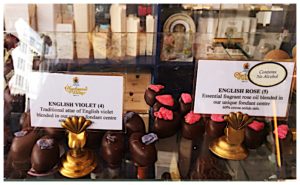 We hone in on the English violet cream, and its sister variety, the English rose cream. Both are dainty and oval shaped, with violet and rose infused fondants respectively, enrobed in dark chocolate. A small sliver of candied violet or rose petal adorns the top of each piece. The dark chocolate is velvety smooth but I find the floral infused fondants to be a tad too sweet. We are recommended the more contemporary dark sea salt caramel truffle and the traditional strawberry truffle. Both are esthetically pleasing, but, again, too sweet for my liking.
We hone in on the English violet cream, and its sister variety, the English rose cream. Both are dainty and oval shaped, with violet and rose infused fondants respectively, enrobed in dark chocolate. A small sliver of candied violet or rose petal adorns the top of each piece. The dark chocolate is velvety smooth but I find the floral infused fondants to be a tad too sweet. We are recommended the more contemporary dark sea salt caramel truffle and the traditional strawberry truffle. Both are esthetically pleasing, but, again, too sweet for my liking.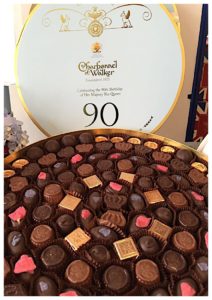
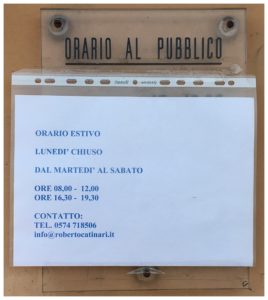 The Italian lunchtime siesta.
The Italian lunchtime siesta.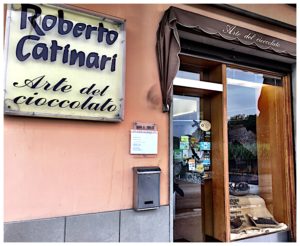
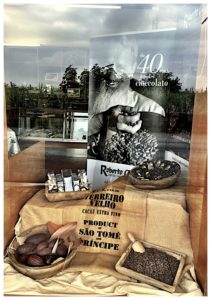 Roberto has spent his lifetime devoted to his passion for chocolates. He started as a teenager in Switzerland, working his way up from dishwasher to the rank of chef in a pastry shop.Then in the 1970s, he decided to return to Tuscany, taking with him his artisanal skills and passion for chocolate making, to open his own shop. Today, more than 40 years on and well into his 70s, Roberto is still going strong and churning out exquisite creations of pralines, chocolate figurines and bars.
Roberto has spent his lifetime devoted to his passion for chocolates. He started as a teenager in Switzerland, working his way up from dishwasher to the rank of chef in a pastry shop.Then in the 1970s, he decided to return to Tuscany, taking with him his artisanal skills and passion for chocolate making, to open his own shop. Today, more than 40 years on and well into his 70s, Roberto is still going strong and churning out exquisite creations of pralines, chocolate figurines and bars.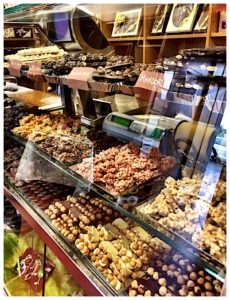 Setting foot into the shop, I am greeted by the ever so inviting aroma of chocolates. The colourful pralines, rochers and bars, behind the gleaming display counter, are a feast for the eyes. The decor isn’t fancy or contemporary. Nonetheless, it wins me over with a sense of warmth and nostalgia.
Setting foot into the shop, I am greeted by the ever so inviting aroma of chocolates. The colourful pralines, rochers and bars, behind the gleaming display counter, are a feast for the eyes. The decor isn’t fancy or contemporary. Nonetheless, it wins me over with a sense of warmth and nostalgia.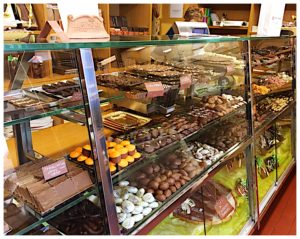 The lovely lady who serves us speaks little English. As the pralines aren’t individually labelled, choosing becomes a tad challenging. Thankfully, we are united in the language of chocolates and find a means to communicate by exchanging names of simple ingredients as we work through our selection.
The lovely lady who serves us speaks little English. As the pralines aren’t individually labelled, choosing becomes a tad challenging. Thankfully, we are united in the language of chocolates and find a means to communicate by exchanging names of simple ingredients as we work through our selection.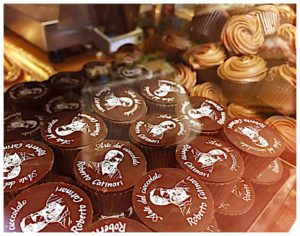 Delicious is an understatement. I am blown away by how good each beautifully hand-made, bite-sized and dainty piece of chocolate tastes. The majority that we selected contain nocciola (hazelnut), either whole, crushed for texture in a praline or as a paste in gianduia. The unique flavours and textures of each are well accentuated.The chocolate itself, made from prized Sao Tome cocoa beans, is rich and smooth with well balanced sweetness.
Delicious is an understatement. I am blown away by how good each beautifully hand-made, bite-sized and dainty piece of chocolate tastes. The majority that we selected contain nocciola (hazelnut), either whole, crushed for texture in a praline or as a paste in gianduia. The unique flavours and textures of each are well accentuated.The chocolate itself, made from prized Sao Tome cocoa beans, is rich and smooth with well balanced sweetness.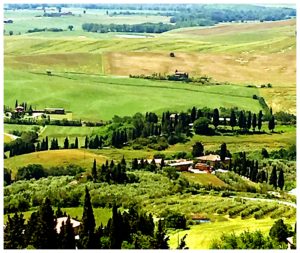 As I bid farewell to the Roberto Catinari experience and our Tuscan Chocolate adventures, I reflect on all that I have learnt and experienced and the chocolate connections that I have made along this journey.
As I bid farewell to the Roberto Catinari experience and our Tuscan Chocolate adventures, I reflect on all that I have learnt and experienced and the chocolate connections that I have made along this journey.